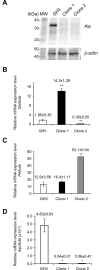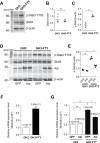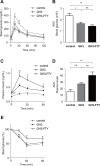Augmented Growth Hormone Secretion and Stat3 Phosphorylation in an Aryl Hydrocarbon Receptor Interacting Protein (AIP)-Disrupted Somatotroph Cell Line
- PMID: 27706259
- PMCID: PMC5051713
- DOI: 10.1371/journal.pone.0164131
Augmented Growth Hormone Secretion and Stat3 Phosphorylation in an Aryl Hydrocarbon Receptor Interacting Protein (AIP)-Disrupted Somatotroph Cell Line
Abstract
Aryl hydrocarbon receptor interacting protein (AIP) is thought to be a tumor suppressor gene, as indicated by a mutational analysis of pituitary somatotroph adenomas. However, the physiological significance of AIP inactivation in somatotroph cells remains unclear. Using CRISPR/Cas9, we identified a GH3 cell clone (termed GH3-FTY) in which Aip was genetically disrupted, and subsequently investigated its character with respect to growth hormone (Gh) synthesis and proliferation. Compared with GH3, GH3-FTY cells showed remarkably increased Gh production and a slight increase in cell proliferation. Gh-induced Stat3 phosphorylation is known to be a mechanism of Gh oversecretion in GH3. Interestingly, phosphorylated-Stat3 expression in GH3-FTY cells was increased more compared with GH3 cells, suggesting a stronger drive for this mechanism in GH3-FTY. The phenotypes of GH3-FTY concerning Gh overproduction, cell proliferation, and increased Stat3 phosphorylation were significantly reversed by the exogenous expression of Aip. GH3-FTY cells were less sensitive to somatostatin than GH3 cells in the suppression of cell proliferation, which might be associated with the reduced expression of somatostatin receptor type 2. GH3-FTY xenografts in BALB/c nude mice (GH3-FTY mice) formed more mitotic somatotroph tumors than GH3 xenografts (GH3 mice), as also evidenced by increased Ki67 scores. GH3-FTY mice were also much larger and had significantly higher plasma Gh levels than GH3 mice. Furthermore, GH3-FTY mice showed relative insulin resistance compared with GH3 mice. In conclusion, we established a somatotroph cell line, GH3-FTY, which possessed prominent Gh secretion and mitotic features associated with the disruption of Aip.
Conflict of interest statement
TT, TN and YT belonged to the Department of Bioregulatory Science of Life-related Diseases of Fukuoka University (Fukuoka, Japan) which was supported financially by a donation from MSD K. K. This does not alter our adherence to PLOS ONE policies on sharing data and materials.
Figures









Similar articles
-
A Novel Mutation of Aryl Hydrocarbon Receptor Interacting Protein Gene Associated with Familial Isolated Pituitary Adenoma Mediates Tumor Invasion and Growth Hormone Hypersecretion.World Neurosurg. 2019 Mar;123:e45-e59. doi: 10.1016/j.wneu.2018.11.021. Epub 2018 Nov 15. World Neurosurg. 2019. PMID: 30447469
-
STAT3 upregulation in pituitary somatotroph adenomas induces growth hormone hypersecretion.J Clin Invest. 2015 Apr;125(4):1692-702. doi: 10.1172/JCI78173. Epub 2015 Mar 16. J Clin Invest. 2015. PMID: 25774503 Free PMC article.
-
The aging suppressor klotho: a potential regulator of growth hormone secretion.Am J Physiol Endocrinol Metab. 2014 Aug 1;307(3):E326-34. doi: 10.1152/ajpendo.00090.2014. Epub 2014 Jun 17. Am J Physiol Endocrinol Metab. 2014. PMID: 24939736
-
Role of Phosphodiesterases on the Function of Aryl Hydrocarbon Receptor-Interacting Protein (AIP) in the Pituitary Gland and on the Evaluation of AIP Gene Variants.Horm Metab Res. 2017 Apr;49(4):286-295. doi: 10.1055/s-0043-104700. Epub 2017 Apr 20. Horm Metab Res. 2017. PMID: 28427099 Review.
-
[Aryl hydrocarbon receptor interacting protein gene and familial isolated pituitary adenomas].Zhongguo Yi Xue Ke Xue Yuan Xue Bao. 2012 Dec;34(6):640-4. doi: 10.3881/j.issn.1000-503X.2012.06.021. Zhongguo Yi Xue Ke Xue Yuan Xue Bao. 2012. PMID: 23286415 Review. Chinese.
Cited by
-
AIP limits neurotransmitter release by inhibiting calcium bursts from the ryanodine receptor.Nat Commun. 2017 Nov 9;8(1):1380. doi: 10.1038/s41467-017-01704-z. Nat Commun. 2017. PMID: 29123133 Free PMC article.
-
GH and IGF System: The Regulatory Role of miRNAs and lncRNAs in Cancer.Front Endocrinol (Lausanne). 2021 Aug 16;12:701246. doi: 10.3389/fendo.2021.701246. eCollection 2021. Front Endocrinol (Lausanne). 2021. PMID: 34484116 Free PMC article. Review.
-
Novel Insights into Pituitary Tumorigenesis: Genetic and Epigenetic Mechanisms.Endocr Rev. 2020 Dec 1;41(6):821-46. doi: 10.1210/endrev/bnaa006. Endocr Rev. 2020. PMID: 32201880 Free PMC article. Review.
-
Medication for Acromegaly Reduces Expression of MUC16, MACC1 and GRHL2 in Pituitary Neuroendocrine Tumour Tissue.Front Oncol. 2021 Feb 15;10:593760. doi: 10.3389/fonc.2020.593760. eCollection 2020. Front Oncol. 2021. PMID: 33680922 Free PMC article.
-
Targeting HTR2B suppresses nonfunctioning pituitary adenoma growth and sensitizes cabergoline treatment via inhibiting Gαq/PLC/PKCγ/STAT3 axis.Neuro Oncol. 2024 Nov 4;26(11):2010-2026. doi: 10.1093/neuonc/noae130. Neuro Oncol. 2024. PMID: 38989697 Free PMC article.
References
-
- Daly AF, Vanbellinghen J-F, Khoo SK, Jaffrain-Rea M-L, Naves LA, Guitelman MA, et al. Aryl hydrocarbon receptor-interacting protein gene mutations in familial isolated pituitary adenomas: analysis in 73 families. The Journal of clinical endocrinology and metabolism. 2007;92:1891–6. 10.1210/jc.2006-2513 . - DOI - PubMed
-
- Leontiou Ca, Gueorguiev M, van der Spuy J, Quinton R, Lolli F, Hassan S, et al. The role of the aryl hydrocarbon receptor-interacting protein gene in familial and sporadic pituitary adenomas. The Journal of clinical endocrinology and metabolism. 2008;93:2390–401. 10.1210/jc.2007-2611 . - DOI - PubMed
-
- Cazabat L, Bouligand J, Salenave S, Bernier M, Gaillard S, Parker F, et al. Germline AIP mutations in apparently sporadic pituitary adenomas: prevalence in a prospective single-center cohort of 443 patients. The Journal of clinical endocrinology and metabolism. 2012;97:E663–70. 10.1210/jc.2011-2291 . - DOI - PubMed
MeSH terms
Substances
LinkOut - more resources
Full Text Sources
Other Literature Sources
Molecular Biology Databases
Research Materials
Miscellaneous

